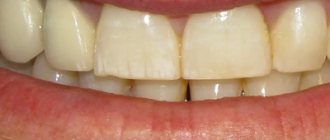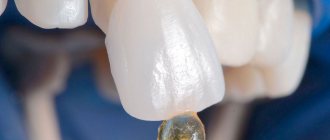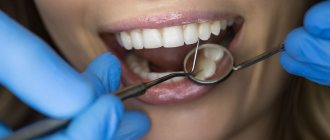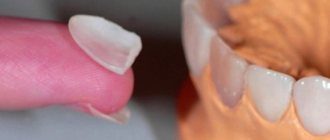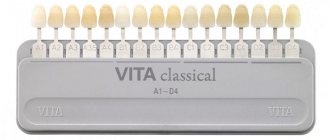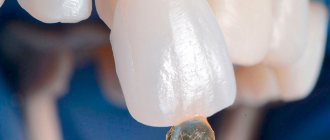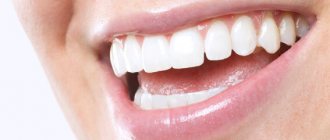A beautiful “Hollywood” smile is the dream of many people. But not many, including Hollywood actors, can boast of it naturally.
To hide imperfections in the front teeth and create a beautiful smile, people are increasingly turning to aesthetic dentistry for help.
Installing veneers is one of the best ways to make your smile perfect today.
Veneers are thin translucent microprosthetic plates that are placed on the front of the teeth to hide visible defects.
Until recently, there were only a few models of dental onlays. And they differed only in material and price. The development of modern technologies has made it possible to bring this field of microprosthetics to a new level, which has expanded the number of ways to restore the attractiveness of a smile.
What materials are veneers made from?
Only veneers made from a ceramic composition can be considered original.
Sometimes in dentistry, visitors are offered the fixation of veneers made of other materials - on an aluminum or zirconium base. As a budget alternative to such veneers, veneers created from composite can be compared. The production of such veneers in the Russian Federation differs significantly from the technologies usual in Europe. True composite veneers must be produced within the framework of a professional dental laboratory operating in dentistry. Veneers are given a shape identical to the parameters of the patient’s teeth. This is achieved through the preliminary creation of impressions. Impressions for veneers are taken by orthopedic dentists during the process of preparing teeth for attaching veneers.
In Moscow, most clinics do not have their own laboratories, so composite veneers are created in violation of real technology. Such veneers turn into analogues of ordinary filling masses. Veneers are fixed on the surface of the front teeth during treatment procedures using standard restorative compounds with light-curing fillings. This turns the veneer into a typical falsification.
Ceramic veneers
Veneers made from high-quality ceramics have long been awarded the title of Hollywood. Such veneers are often considered analogues of indirect veneers and orthopedic veneers. Such names are dictated by the manufacturing features. The creation of such veneers is not done in dentistry during the session, but in a special laboratory before the start of therapy.
In all the variety of ceramic veneers, two large varieties can be distinguished. In addition to porcelain veneers, Moscow dentists suggest considering the installation of veneers made of zirconium alloys.
Porcelain veneers
Porcelain is rightfully considered the base material for creating veneers. It is most similar to the appearance of human tooth enamel and its structure. The increased strength of the material and the preservation of color throughout the entire service life of the veneers cannot be ignored. Additional translucency improves the aesthetic qualities of veneers.
restoration of front teeth with veneers before and after photos
Quite often, patients are not satisfied with the condition of the restoration of their front teeth. To correct the situation, dental specialists suggest completely eliminating the unsuccessful restoration and fixing veneers made of first-class porcelain to the teeth.
There are two methods that can be used to make porcelain veneers:
The first technique helps achieve maximum aesthetics, and the second is aimed at obtaining maximum strength indicators of the incisors. The method according to which the specialist will act is determined by the dentistry you contacted. The average production time for veneers ranges from one to two weeks. At this time, your ground teeth will be covered with special temporary veneers made of high-quality plastic.
Veneers. Method of layer-by-layer application of porcelain mass and firing it
One of the most common situations considered by employees of any dentistry is the creation of veneers for the fourth and fifth teeth. Dentists prefer to apply a special porcelain mixture to the client’s prepared teeth. It is distributed over the teeth gradually and in layers. During the work process, a dental specialist can vary the thickness, color and level of transparency of the layer to create the highest quality veneers on the visitor’s teeth. This technique allows you to achieve a perfect match of the color of nearby teeth. This is what gives the look a natural look.
Veneers. Injection molding method under pressure and high temperature
Now we are talking about “pressed ceramics”. Veneers produced using this method become less fragile, which contributes to long-lasting wear and increased reliability.
Porcelain veneers for front teeth: before and after photos
Zirconium dioxide ceramic veneers
Zirconium veneers have two layers. The lower one is made up of a high-strength zirconium frame, and the outer surface of the veneer is represented by a porcelain mass. The frame is created using a unique technology of three-dimensional milling of veneers. Dentistry using this technology must have CNC machines. They do not require human intervention, therefore they guarantee products of impeccable quality and accuracy.
The procedure consists of several successive steps. First, in dentistry, a specialist grinds the patient’s teeth for installation of veneers, after which he makes a reliable impression of each incisor being processed. Based on the impression taken, a virtual three-dimensional model of the future veneer will be built using special dental equipment. The operator transfers the data of the simulated veneer to the machine for turning the workpiece.
Zirconium veneers are stronger and harder than pressed porcelain veneers. An excellent result can be achieved in any dentistry in Moscow if its employees strictly follow the technology of firing the resulting blanks for veneers. Unfortunately, it is not uncommon for clinics to violate accepted technology. The technique is completely new, and not every dentist has managed to master it at the proper level. Deviation from the original technology is fraught with the formation of chips on the ceramics after installing veneers on a patient.
Making veneers photo process
Ceramic veneers: reviews, advantages
In addition to excellent aesthetics, installing ceramic veneers in dentistry can achieve:
- — complete color stability throughout the entire service life of the veneers;
- - incredible reliability (the service life of veneers is limited only by a person receiving dental injuries in extreme situations).
The only drawback of ceramic veneers is their rather high price.
Differences between porcelain veneers and zirconium dioxide veneers: By installing porcelain veneers, dental professionals are able to achieve incredible translucency of the material. Zirconium products have more modest translucency indicators because they have increased density.
For patients with a high level of transparency in their own teeth, it is advisable to choose veneers made from a porcelain mixture. For some clients, the tooth enamel has a more saturated color. Then veneers of these two varieties will be quite appropriate. Porcelain veneers can be given the desired degree of translucency by varying the number of layers.
Sign up for a consultation at our clinic
Temporary structures
Attention! Before installing ceramic plates, the teeth are prepared. During the procedure, the top layer of dental tissue as thick as the future veneer is removed. After grinding the tooth, an impression is taken from which a microprosthesis will be made.
The prepared tooth becomes sensitive, and temporary restorations are used to protect it until a permanent veneer is installed. Such products are usually made of plastic. Their service life is very short, they are very fragile and come off easily. However, plastic veneers successfully cope with their task of protecting the patient’s smile for 1 – 2 weeks.
Composite veneers
Installing veneers made of composites has certain disadvantages.
You can study reviews from patients who have already visited the dentist for this service. This will help you evaluate whether these veneers are right for you. We have collected information from specialists who work in the best dentistry in the country. They note that in the vast majority of cases, dentists create composite veneers directly during a session directly in the visitor’s mouth. This turns veneers into reinforced restoration fillings. The filling is distributed over the front surface of the tooth, but its cost is an order of magnitude higher than a traditional restoration. This technology has nothing in common with classic veneers and is unable to perform their functions. The production of high-quality composite veneers is carried out outside of dentistry - in the laboratory of a dental technician.
The task of dentists is to grind down the teeth to cover them with veneers and take reliable impressions of them. The impressions must be sent to the dentist. The specialist creates a veneer on a light composite, providing it with the necessary qualities. Such veneers acquire high performance properties, but their characteristics cannot be compared with porcelain and zirconium analogues.
Composite veneers: reviews from dentists
Tooth restoration with a composite veneer. Photos before and after
Considering modern composite veneers, one can note their modest aesthetic qualities. Such a coating is not capable of achieving the performance of ceramic veneers. Most patients encounter a problem when a visit to the dentist ends with the fixation of a veneer that does not match the rest of the teeth. Composite compositions are difficult to adapt to the characteristics of natural teeth.
Color stability of composite veneers
Among the indicators of composite veneers, the level of color stability ranks last. During use, such veneers gradually begin to lose their brightness and color. Varieties of ceramic veneers are not susceptible to this, since this material does not change color shade and translucency throughout the entire period of operation.
Strength of materials
Veneers made of composite material are more fragile than ceramic type veneers. Their reliability is incomparable to that of veneers made from zirconium compounds, which have unsurpassed strength. Due to their high fragility, such veneers are installed with the obligatory overlap of the cutting edge of the tooth. This means that you will no longer bite food with your own tooth, but with the veneer.
Manufacturing technology of composite veneers
Dental professionals face quite a difficult task. They need to create a high-quality veneer in your mouth. Achieving the goal is hampered not only by limited time, but also by high humidity and the presence of only artificial lighting. The desired color shade of the veneer can be achieved only by gradual layer-by-layer application of the filling composition. The required shade of veneer is selected for each layer. Creating high-quality veneers in laboratories takes longer and is much more expensive. As for their characteristics, these veneers will significantly surpass in their qualities analogues created in dentistry itself.
How to install veneers
The creation of veneers is carried out in several successive stages. First, the dental employee prepares the teeth. If outdated composite fillings are installed on the surface of the tooth or the patient used braces, they are removed. Old fillings are replaced with new ones if the procedure involves preserving the base of the filling after the preparation is completed. This not only improves the aesthetics of the veneer, but also improves adhesion between surfaces.
The second stage of work includes choosing the color shade of the veneers. For this purpose, special scales of shades and colors are used. They are standard and present in any dentistry in Moscow. In addition to tools, the specialist focuses on the client’s personal wishes.
Next, they begin to prepare the teeth. Installation of veneers is carried out after grinding down about 0.5 - 0.7 mm of the natural tooth enamel located on its front surface. At the same time, the installed fillings are polished. The exact size of the enamel layer to be polished is determined individually in dentistry.
The fourth step is making dental impressions. Impressions can be made after the teeth have been prepared. They are sent to a dental technology laboratory operating in dentistry. During the period of production of permanent veneers, the patient is given a temporary alternative. Temporary veneer is designed to protect the patient’s exposed teeth from aggressive environments and food contact with their surface. As part of the laboratory stage, accurate plaster models of the client’s teeth are made. They are necessary to create the most accurate veneers from ceramic or zirconium alloy.
This example shows the stages of placing veneers. Photos before and after
At the final stage, the veneers are fixed using special pastes of two different colors. The color of the cement is matched to the color of the dental client’s enamel, as this determines the final shade of the finished veneer. The dentist’s task is to give the veneer a tone that is as close as possible to the color of the adjacent teeth. The desired shade can be achieved by alternating two shades of fixing pastes. A permanent veneer is glued onto the prepared base.
While in dentistry, you can conduct a dialogue with a specialist and tell him about your claims regarding the quality of the veneer, its color or shape. From the moment the veneer is secured with permanent cement, nothing can be changed. It is easier to remove braces than to adjust permanent veneers.
Ultraneers
Ultraneers
They appeared relatively recently and serve as a good alternative to American lumineers. This type of onlay was developed in Russia based on patented ceramics of the IPS E. MAX brand.
Using modern technologies, pressed ceramics are produced from which ultra-thin plates are created - ultraneers.
Pros of ultra training:
- high aesthetics - the color of the lining can be matched exactly to the natural shade of the patient’s teeth;
- It can also be installed on sensitive teeth, since the grinding of the supporting tooth is minimal or not done at all;
- strength is 40% higher than that of ceramic veneers;
- since this is a completely Russian development, the cost does not depend on currency fluctuations and is therefore lower than the cost of lumineers;
- no need to wait several months before installation, since the product is manufactured in Russia;
- service life is about 15 years.
A significant disadvantage of ultranir is their high cost. They are 2 times more expensive than veneers, although they are produced in Russia. However, the cost of ultraneers is 30-40% lower than the cost of American lumineers.
Veneers: service life, reviews
Dental patients often have doubts about the strength of veneers, because their thickness is very small. Porcelain is one of the highly durable materials, but it is fragile. In order for the veneer to gain durability, it is fixed to a strong base of natural tooth enamel. This allows for a strong, durable and reliable design.
Experts conducted studies that allowed them to evaluate the “survival” of veneers. After 7 years of use, in 86% of cases, veneers that do not overlap the cutting edge of the tooth retained their appearance unchanged. For veneers that covered the incisal edge of the tooth, the survival rate reached 96%. this indicates the incredible reliability of ceramic veneers and the minimal likelihood of problems with them. More often, dental patients complain about braces than they experience difficulties with veneers installed on their teeth.
Often, braces and veneers lose their characteristics due to the fault of the clients themselves. Violation of oral hygiene, sudden severe injuries, and exposure of teeth to critical temperatures are unacceptable.
Composite veneers: reviews
The service life of composite veneers is limited to 2-3 years. In an ideal situation, if the dentist strictly followed the technology, the period of use of veneers will increase to 4 years. Like braces, they require periodic maintenance. Composite veneers need to be polished regularly. This will not stop the gradual fading and darkening of the surface.
Preparatory process
1. Hygienic teeth cleaning, plaque removal.
2. Grind down a thin layer of enamel, from 0.5 to 0.7 mm.
3. A harmonious shade is selected.
4. The remaining enamel is coated with a special acid.
5. An impression is made.
6. The tooth plate is carefully polished and onlays are inserted.
A thin layer of enamel is ground off in order to achieve the most harmonious and natural look. They also grind it in order to insert and firmly strengthen the plate.
Veneers: pros and cons
The greatest difficulty for dental patients arises when choosing between installing crowns or veneers. If a specialist has not identified any contraindications for you to install veneers, then it is better to give them preference. When contraindications are still present, stop at crowns. Minor crooked teeth can be corrected with braces.
What is better - veneer or crown?
What are the differences between crowns and veneers? To install a crown, teeth are sharpened on all sides, removing up to 2 mm of enamel. The prepared tooth will resemble a small stump. Attaching a veneer requires processing only the front surface of the tooth, and the specialist removes a much thinner layer of enamel.
What is better: veneers or restoration?
Among the characteristic qualities of porcelain veneers, one can note their unique ability to create an imitation of the natural tissues of human teeth. Porcelain has a structure very similar to tooth enamel, which allows you to achieve excellent results. The specialist gives the veneer the required translucency. The material will reflect light just like a real human tooth.
The performance of light-polymer filling compounds cannot be compared with the performance of porcelain veneers. The restoration composition will not be so noticeable under braces, but it cannot fully perform the function of veneers. It does not have the required translucency and is extremely limited in color palette. Filled front teeth have poor aesthetics due to all of the above.
The restoration tends to darken as it wears, so fillings must be changed regularly. Often, a darkened border appears on the border between healthy tooth enamel and the filling compound, which causes a lot of discomfort to the patient. Porcelain veneer will not lose its color and transparency for several decades.
Which is better: braces or veneers?
This example shows a patient who chose veneers over braces. Photos before and after
To make a choice between veneers and braces, it is necessary to assess the degree of deformation of the teeth and disruption of their normal position. Veneers can only deal with minimal defects. Braces will help to refrain from grinding down the healthy enamel of a number of teeth and will restore the normal position of the incisors with minimal loss.
The concept of high technology can be applied to modern braces. Such braces can eliminate traces of slight crowding of teeth for six months. It takes up to one and a half years to get rid of complex disorders. In addition to standard metal braces, Moscow dentists also offer invisible models made of transparent sapphire.
Those clinic patients for whom it is important to eliminate minor dental defects in a short period of time, not exceeding three weeks, refuse to install veneers instead of braces. We hope you found answers to your questions in our article and learned a lot about dental veneers and their main differences from other methods of eliminating aesthetic dental defects.
What do teeth look like before installation?
Before veneers are placed, the patient is thoroughly examined. Using computer modeling, the dentist can show what results to expect from the procedure. A photo of the teeth before veneers is presented below.
Patients who want to have veneers have the following problems before the procedure:
- local darkening of the enamel;
- color change after depulpation;
- fillings on the front side of the incisors;
- cracks and chips;
- violation of the integrity of the enamel;
- too short incisors;
- erased edge of the smile line;
- gaps between incisors;
- visual defects.
Before the installation of masking onlays, the teeth of patients in 99% of cases look unattractive, since people with healthy incisors and a beautiful smile do not need restoration.
Cost of work
The cost of microprosthetics depends on the type of veneer chosen, the status of the dental clinic and the qualifications of the doctor. The most budget option is to install cladding made of composite materials using the direct method. However, its service life is short and there are more situations when this method will not be effective. Restorative composite veneers are approximately three times cheaper than orthopedic ones made from medical porcelain. Zirconium linings will cost even more.
The cost of a perfect smile is also affected by the number of teeth requiring restoration. A good aesthetic result is achieved by installing a minimum of four and a maximum of ten veneers.
I came with one problem. But the diagnosis is completely different
Diagnosis
— dysfunction of the TMJ (temporomandibular joint), one of the manifestations of which is hypertonicity of the masticatory muscles, as a result of which signs of overload appeared on the teeth: gum recession, multiple abfractions (chips of enamel in the neck of the teeth), violation of the marginal seal (de-cementation), marginal gingivitis, unsatisfactory aesthetic appearance of teeth.
I was surprised as a doctor:
- lack of planning
for the aesthetic result (the patient did not expect and did not know what her teeth would look like as a result of treatment), - failure to take into account
the functional overload of the patient’s teeth when planning this work, - the orthopedic stage
was performed incorrectly - discrepancy between the edge of the veneer and the ledge carved on the tooth (the place where the veneer transitions into the tooth), discrepancy between the shape of the teeth and the facial proportions of the patient, - as well as preparation of teeth, fixation of new structures in the oral cavity.
The inflammatory process, gingivitis, is caused by the fact that the edge of the veneer does not reach the planned preparation line on the tooth by 1.5 - 2 mm, which leads to the accumulation of bacteria and food debris on the dentin surface of the tooth exposed as a result of drilling. And also a low level of self-hygiene and a lack of completely professional hygiene in the dentist’s chair over the year that has passed since the fixation.
History of appearance
Veneers owe their appearance to Hollywood. To create a flawless and charming smile, the stars of the 30s of the last century had thin plates glued to the front side of their teeth. The manufacturing and fastening technology was developed by dentist Ch. Pincus. The plastic petals were fixed to the actors’ teeth with adhesive powder and lasted no more than a week, but the effect was amazing. Over the course of several filming sessions, dark, uneven teeth became snow-white and perfectly set. Pincus veneers were, rather, elements of makeup or props, but the idea of correcting a smile in this way eventually found wide application in aesthetic dentistry.
Modern equivalents of Pincus plates have undergone significant changes in both the manufacturing and installation process, but they are sometimes still referred to as "Hollywood" plates.
Historical reference
Composite materials are modified plastics with improved aesthetic, strength and handling properties. Their connection with tooth tissues is due to adhesion.
Adhesion (Latin adhesio - fusion, adhesion) is the phenomenon of adhesion between two surfaces brought into contact. Systems created on the basis of this phenomenon are widely used in dentistry.
Currently, there are seven generations of these systems , with the fourth to seventh being used in clinical practice. They differ from each other in adhesion strength, the relationship of the components (separately or in combinations) and indications for use.
The widespread use of veneers dates back to the 1980s.
Contraindications
The patient will be denied the procedure if at least one of the following contraindications is present:
- extensive progressive caries , as well as pathology, accompanied by an abscess or periodontitis;
- looseness of the dentition or its individual fragments;
- excessively thin outer surface of the enamel and its external damage;
- bruxism;
- partial eruption of the organ;
- direct malocclusion.
It is worth noting that the only possible way to correct existing defects with such anomalies is orthopedic crowns.
All about the diagnostic approach and treatment of candidal stomatitis using traditional and non-traditional methods. Read reviews about the Panasonic ew 1211 irrigator here.
At this address https://dr-zubov.ru/ortodontiya/apparaty/kappy/kak-vyrovnyat-zuby-bez-breketov.html you will learn how to straighten your front teeth without braces.




